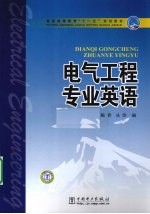图书介绍
电气工程专业英语PDF|Epub|txt|kindle电子书版本网盘下载

- 陈青,丛伟编著 著
- 出版社: 北京:中国电力出版社
- ISBN:9787512300682
- 出版时间:2010
- 标注页数:251页
- 文件大小:21MB
- 文件页数:259页
- 主题词:电气工程-英语-高等学校-教材
PDF下载
下载说明
电气工程专业英语PDF格式电子书版下载
下载的文件为RAR压缩包。需要使用解压软件进行解压得到PDF格式图书。建议使用BT下载工具Free Download Manager进行下载,简称FDM(免费,没有广告,支持多平台)。本站资源全部打包为BT种子。所以需要使用专业的BT下载软件进行下载。如BitComet qBittorrent uTorrent等BT下载工具。迅雷目前由于本站不是热门资源。不推荐使用!后期资源热门了。安装了迅雷也可以迅雷进行下载!
(文件页数 要大于 标注页数,上中下等多册电子书除外)
注意:本站所有压缩包均有解压码: 点击下载压缩包解压工具
图书目录
Unit 1 Basic Theory for Electrical Engineering1
1.1 Electricity and Electromagnetic1
1.1.1 What Electricity Is1
1.1.2 Faraday's Law of Electromagnetic Induction2
1.1.3 Magnetic Field3
1.2 Engineering Circuit Analysis6
1.2.1 Inductance and Capacitance6
1.2.2 Circuit Analysis7
1.3 Electronics and Automation10
1.3.1 Logic Devices10
1.3.2 Digital Circuits13
1.3.3 Digital Signal Processing16
1.4 Microcomputer19
1.4.1 Single-Chip Microcomputer19
1.4.2 Microprocessor20
1.4.3 Microprocessor Applications22
1.4.4 Computer System Software24
Unit 2 Electrical Machines28
2.1 Alternating-Current Machines28
2.1.1 General28
2.1.2 Synchronous Generator Principle and Construction Features29
2.1.3 Synchronous Generator Performance31
2.1.4 Synchronous Motors33
2.2 Synchronous Machine Theory and Modeling35
2.2.1 Physical Description35
2.2.2 Mathematical Description of a Synchronous Machine39
2.2.3 Basic Equations of a Synchronous Machine43
2.2.4 The dq0 Transformation48
2.3 Induction Motor52
2.3.1 A General Outline of Induction Machines52
2.3.2 Induction Motor Action54
2.3.3 Construction Features of an Induction Motor55
2.3.4 Running Conditions of an Induction Motor58
2.4 Transformer59
2.4.1 Single-phase Transformer Model59
2.4.2 Equivalent Circuits for Practical Transformers63
2.4.3 Three-Phase Transformer Connections67
2.4.4 Per Unit Normalization70
Unit 3 Power Electronics74
3.1 Understanding FACTS:Basic Concept and General System Consideration74
3.1.1 Opportunities for FACTS74
3.1.2 Basic Types of FACTS Controllers77
3.1.3 Description and Definitions of FACTS Controllers-shunt Connected Controllers80
3.1.4 Basic Description and Definitions of FACTS Controllers-series Connected Controllers and Combined Controllers85
3.1.5 Possible Benefits from FACTS Technology88
3.2 Power Semiconductor Devices93
3.2.1 Perspective on Power Devices93
3.2.2 Integrated Gate-Commutated Thyristor and Insulated Gate Bipolar Thyristor98
3.3 Static Compensators and Combined Compensators101
3.3.1 Static Shunt Compensators:SVC and STATCOM101
3.3.2 Static Series Compensators:Thyristor-Controlled Series Capacitor(TCSC)103
3.3.3 The Unified Power Flow Controller(UPFC)108
3.4 High Voltage Direct Current(HVDC)Transmission Systems Technology Review Paper111
3.4.1 Introduction to HVDC111
3.4.2 Advances in Technology and the Roles of HVDC115
3.4.3 Design,Operation,Maintenance and Cost Considerations119
3.4.4 HVDC Applications124
Unit 4 Electric Power System128
4.1 Introduction128
4.1.1 Evolution of Electric Power Systems128
4.1.2 Present and Future Trends of Power Systems130
4.1.3 Structure of the Power System132
4.1.4 Power System Control134
4.1.5 Introduction to EHV AC Transmission138
4.2 Electric Power Generation140
4.2.1 Introduction140
4.2.2 Power Station141
4.2.3 Automatic Generation Control144
4.2.4 Engineer's Role in Power Generation147
4.3 Electric Power System Operation151
4.3.1 Power System Planning151
4.3.2 Power System Load153
4.3.3 Reactive Power155
4.3.4 Power System Monitoring156
4.3.5 Economic Dispatching158
4.4 Power System Stability Problem161
4.4.1 Basic Concepts and Definitions161
4.4.2 Rotor Angle Stability162
4.4.3 The Stability Phenomena164
4.4.4 Mid-Term and Long-Term Stability165
4.4.5 Origin of Overvoltages and Their Types166
4.5 Fault and Relaying Protection168
4.5.1 Faults in Power System168
4.5.2 Role of Protection in a Power System169
4.5.3 Some Components of Protection171
4.5.4 Fundamental Protection Principles174
Unit 5 Distributed Power Generation176
5.1 Distributed Generation Versus Traditional Power Systems176
5.1.1 Distributed Versus Central Station Generation176
5.1.2 Other Advantages and Disadvantages of DG178
5.1.3 Power"from the Grid"as a Target for DG179
5.2 Renewable Resource Distributed Generators181
5.2.1 Introduction181
5.2.2 Solar Thermal Power Generation182
5.2.3 Photovoltaic(PV)Generation184
5.2.4 Wind-Powered Generation186
5.2.5 Other Renewable Generation Resources189
5.3 Energy Storage for Use with Distributed Generation192
5.3.1 Chemical,Electrical,or Physical Storage Systems for Electrical Energy192
5.3.2 Battery Storage193
5.3.3 Superconducting Magnetic Energy Storage(SMES)195
5.3.4 Capacitor Storage197
5.3.5 Mechanical Storage:Flywheels200
5.4 Basic DG Case:Grid Interconnection Options202
5.4.1 Potential Advantages of Interconnection202
5.4.2 Potential Disadvantages of Interconnection204
5.4.3 What Type of DG-Grid Interconnection?206
5.4.4 Advantages and Disadvantages of DG-Grid Interconnection207
Unit 6 专业英语的阅读、翻译与写作210
6.1 专业英语的特点210
6.2 专业英语中的特殊语法现象212
6.3 专业英语中的常用句型215
6.4 专业英语的翻译222
6.4.1 被动语态的译法222
6.4.2 倍数、分数和百分数的译法223
6.4.3 定语从句的译法223
6.4.4 名词性从句的译法224
6.4.5 状语从句的译法225
6.5 专业英语的写作225
6.5.1 学术论文写作225
6.5.2 简历229
6.5.3 商务信函230
6.5.4 产品技术说明书232
词汇表233
常用专业词汇244
常用国外专业期刊名称249
参考文献251